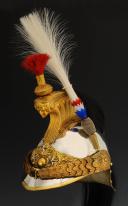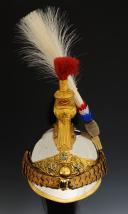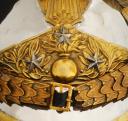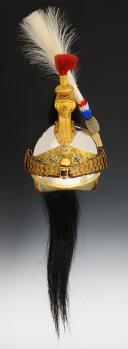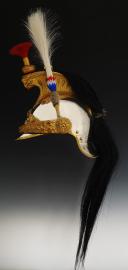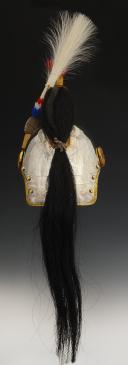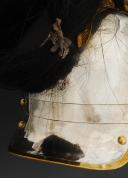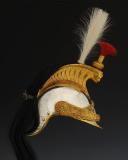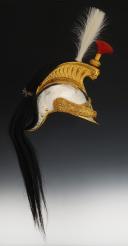
HELMET OF A GENERAL OF A DIVISION OF CUIRASSIERS, model 1872 modified 1874, Third Republic. 27167
Sold out
DIVISION GENERAL OF CUIRASSIERS HELMET, 1872 model modified in 1874, Third Republic. 27167
Silver-plated copper shell, stamped at the balance, planished with a hammer. Punched at the top with three vent holes. Visor inclined at 53 degrees below a horizontal plane passing through the junction of the visor and the shell. Edged with a 17 mm wide gilded copper circle placed on top of its edges and fixed at the ends by a rivet. Underside of the visor later lacquered green. Neck guard composed of: a circular band on its surface, welded under the rear edge of the band it extends, it has three golden brass nails with half-spherical heads riveted inside; a second concave band, forming a groove, with rounded angles and welded inside, at the bottom of the first. Like the visor, the neck guard is edged with a 17 mm wide gilded copper border, placed on top. Underside of the neck guard covered in ochre buff leather.
Gilded copper headband embossed with a flaming grenade surrounded by laurel leaves, adherent to the shell. Its base rests on the visor and its ends are riveted to the shell in the part masked by the rosette of the chinstrap. The shell is decorated with three stars, one placed on each side and one at the top, star diameter 1.7 cm.
Each chinstrap is composed of 9 ornamental copper scales, embossed in relief with laurel leaves, which decrease in width. These scales are fastened with flat iron wire staples on a core of leather lined with black velvet. Rectangular brass buckle with a tightening screw on its front part. At the other end, a black varnished calf leather chinstrap. The upper scale of each chinstrap is finished with a rounded part embossed with a circular rosette depicting relief laurel leaves. It is attached to the shell by a lock.
The shell is topped with a gilded copper crest composed of two fins, a mask, and a covering.
The fins, placed vertically at a distance of 32 mm in front and 25 mm behind each other, have the shape of a convex curvilinear triangle at the top that connects to the shell with its concave base forming a scalloped edge.
This edge is fastened to the shell by copper round-headed suet-drop screws that are secured inside the helmet by square copper nuts.
The fins are adorned with palmettes and a border on their upper edge; the edge is decorated with water leaves, all embossed in relief.
A tin-plated plate joins the upper edges of the fins fixing their spacing.
The mask serving as the front junction of the two fins through a soldering, is embossed with a relief head of Medusa. The covering, also stamped, represents the continuation of the Medusa head's hair with intertwined snakes.
Crest ornament composed of an embossed socket of relief water leaves and a lens formed by two embossed shells. Fixed on the front of the crest and supporting a scarlet horsehair plume, height 4.5 cm.
Black dyed horsehair mane, mounted on a strong nourished cow leather sole, in which the hair is assembled with tinned brass threads with a buff leather piece glued with strong glue on the assembly; the empty space between the two rows of hair is filled with a braid that starts from the top and follows the curve of the crest to its junction with the shell. The mane is attached to the crest with two copper screws with nuts. Mane length approximately 70 cm.
An embossed copper plume holder, H 35 mm, forming a square section socket, fixed obliquely.
Interior lining in black varnished leather gold pressed on the outer edges, cut with seven wolf teeth, each fitted with a metal eyelet.
Superior officer plume in heron feathers with a base in tricolor feathers mounted on a whalebone and iron stem. Height of visible feathers 29 cm, with the tricolor feathers being 5 cm. Olive in silver bullion.
France.
Third Republic.
Very good condition, perfect gilding, visor underside later lacquered green.
NOTE:
General helmets for the 1874 models are always very complicated to authenticate with certainty. Normally, manufacturers mounted the stars on the headband by means of rivets before attaching the headband to the shell, as is the case here. However, colonels who were promoted to the rank of general had their helmets modified at the time by disassembling the headband and then reassembling it. Nowadays, it is often complicated, if not impossible, to determine if the mounting of these stars is perfectly original. On the helmet we present, the headband seems to have never been disassembled and the overall finish of the helmet is of high quality, which suggests the integrity of the piece.
Silver-plated copper shell, stamped at the balance, planished with a hammer. Punched at the top with three vent holes. Visor inclined at 53 degrees below a horizontal plane passing through the junction of the visor and the shell. Edged with a 17 mm wide gilded copper circle placed on top of its edges and fixed at the ends by a rivet. Underside of the visor later lacquered green. Neck guard composed of: a circular band on its surface, welded under the rear edge of the band it extends, it has three golden brass nails with half-spherical heads riveted inside; a second concave band, forming a groove, with rounded angles and welded inside, at the bottom of the first. Like the visor, the neck guard is edged with a 17 mm wide gilded copper border, placed on top. Underside of the neck guard covered in ochre buff leather.
Gilded copper headband embossed with a flaming grenade surrounded by laurel leaves, adherent to the shell. Its base rests on the visor and its ends are riveted to the shell in the part masked by the rosette of the chinstrap. The shell is decorated with three stars, one placed on each side and one at the top, star diameter 1.7 cm.
Each chinstrap is composed of 9 ornamental copper scales, embossed in relief with laurel leaves, which decrease in width. These scales are fastened with flat iron wire staples on a core of leather lined with black velvet. Rectangular brass buckle with a tightening screw on its front part. At the other end, a black varnished calf leather chinstrap. The upper scale of each chinstrap is finished with a rounded part embossed with a circular rosette depicting relief laurel leaves. It is attached to the shell by a lock.
The shell is topped with a gilded copper crest composed of two fins, a mask, and a covering.
The fins, placed vertically at a distance of 32 mm in front and 25 mm behind each other, have the shape of a convex curvilinear triangle at the top that connects to the shell with its concave base forming a scalloped edge.
This edge is fastened to the shell by copper round-headed suet-drop screws that are secured inside the helmet by square copper nuts.
The fins are adorned with palmettes and a border on their upper edge; the edge is decorated with water leaves, all embossed in relief.
A tin-plated plate joins the upper edges of the fins fixing their spacing.
The mask serving as the front junction of the two fins through a soldering, is embossed with a relief head of Medusa. The covering, also stamped, represents the continuation of the Medusa head's hair with intertwined snakes.
Crest ornament composed of an embossed socket of relief water leaves and a lens formed by two embossed shells. Fixed on the front of the crest and supporting a scarlet horsehair plume, height 4.5 cm.
Black dyed horsehair mane, mounted on a strong nourished cow leather sole, in which the hair is assembled with tinned brass threads with a buff leather piece glued with strong glue on the assembly; the empty space between the two rows of hair is filled with a braid that starts from the top and follows the curve of the crest to its junction with the shell. The mane is attached to the crest with two copper screws with nuts. Mane length approximately 70 cm.
An embossed copper plume holder, H 35 mm, forming a square section socket, fixed obliquely.
Interior lining in black varnished leather gold pressed on the outer edges, cut with seven wolf teeth, each fitted with a metal eyelet.
Superior officer plume in heron feathers with a base in tricolor feathers mounted on a whalebone and iron stem. Height of visible feathers 29 cm, with the tricolor feathers being 5 cm. Olive in silver bullion.
France.
Third Republic.
Very good condition, perfect gilding, visor underside later lacquered green.
NOTE:
General helmets for the 1874 models are always very complicated to authenticate with certainty. Normally, manufacturers mounted the stars on the headband by means of rivets before attaching the headband to the shell, as is the case here. However, colonels who were promoted to the rank of general had their helmets modified at the time by disassembling the headband and then reassembling it. Nowadays, it is often complicated, if not impossible, to determine if the mounting of these stars is perfectly original. On the helmet we present, the headband seems to have never been disassembled and the overall finish of the helmet is of high quality, which suggests the integrity of the piece.
Reference :
27167
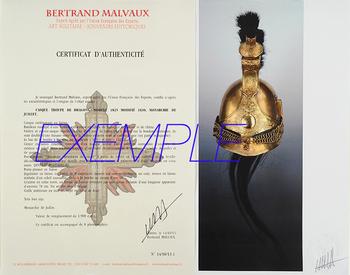
Next update Friday, January 2 at 13:30 PM
FOR ALL PURCHASES, PAYMENT IN MULTIPLE CHECKS POSSIBLE
bertrand.malvaux@wanadoo.fr 06 07 75 74 63
SHIPPING COSTS
Shipping costs are calculated only once per order for one or more items, all shipments are sent via registered mail, as this is the only way to have proof of dispatch and receipt.
For parcels whose value cannot be insured by the Post, shipments are entrusted to DHL or Fedex with real value insured, the service is of high quality but the cost is higher.
RETURN POLICY
Items can be returned within 8 days of receipt. They must be returned by registered mail at the sender's expense, in their original packaging, and in their original condition.
AUTHENTICITY
The selection of items offered on this site allows me to guarantee the authenticity of each piece described here, all items offered are guaranteed to be period and authentic, unless otherwise noted or restricted in the description.
An authenticity certificate of the item including the description published on the site, the period, the sale price, accompanied by one or more color photographs is automatically provided for any item priced over 130 euros. Below this price, each certificate is charged 5 euros.
Only items sold by me are subject to an authenticity certificate, I do not provide any expert reports for items sold by third parties (colleagues or collectors).
FOR ALL PURCHASES, PAYMENT IN MULTIPLE CHECKS POSSIBLE
bertrand.malvaux@wanadoo.fr 06 07 75 74 63
An authenticity certificate of the item including the description published on the site, the period, the sale price, accompanied by one or more color photographs is automatically provided for any item priced over 130 euros. Below this price, each certificate is charged 5 euros.
Only items sold by me are subject to an authenticity certificate, I do not provide any expert reports for items sold by third parties (colleagues or collectors).
